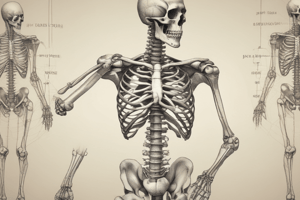Podcast
Questions and Answers
What are the four bones in the proximal row of the carpal bones?
What are the four bones in the proximal row of the carpal bones?
Scaphoid, lunate, triquetrum, pisiform
Which carpal bone is the largest and fuses with the lunate at its head portion?
Which carpal bone is the largest and fuses with the lunate at its head portion?
Capitate
What is responsible for the close association of the tendons of forearm muscles with the carpal bones?
What is responsible for the close association of the tendons of forearm muscles with the carpal bones?
Retinacula
What syndrome arises due to the narrowing of the carpal tunnel?
What syndrome arises due to the narrowing of the carpal tunnel?
What is the name of the spine located above the tuberosity that constricts the pelvic outlet in women during parturition?
What is the name of the spine located above the tuberosity that constricts the pelvic outlet in women during parturition?
What is the largest foramen in the entire skeleton that provides access for blood vessels and nerves to the ischium?
What is the largest foramen in the entire skeleton that provides access for blood vessels and nerves to the ischium?
Which joint connects the two pubis of the hip bones?
Which joint connects the two pubis of the hip bones?
What boundary line separates the pelvis into superior and inferior portions?
What boundary line separates the pelvis into superior and inferior portions?
Which bone in the lower limb is regarded as the heaviest and strongest bone in the body?
Which bone in the lower limb is regarded as the heaviest and strongest bone in the body?
What is the region of the femur that immediately follows the neck called?
What is the region of the femur that immediately follows the neck called?
What structures at the distal end of the femur tend to fuse with the condyles of the tibia?
What structures at the distal end of the femur tend to fuse with the condyles of the tibia?
How many bones are located in the ankle region of each lower limb?
How many bones are located in the ankle region of each lower limb?
Which bone is regarded as the most slender bone of the body?
Which bone is regarded as the most slender bone of the body?
What is the name of the projection where fusion occurs between the talus of the ankle and the distal end of the fibula?
What is the name of the projection where fusion occurs between the talus of the ankle and the distal end of the fibula?
How many ankle bones (tarsal bones) make up the proximal part of the foot?
How many ankle bones (tarsal bones) make up the proximal part of the foot?
Which tarsal bone is thick and the largest bone of the ankle?
Which tarsal bone is thick and the largest bone of the ankle?
Flashcards are hidden until you start studying
Study Notes
Carpal Bones
- The four bones in the proximal row of the carpal bones are not specified.
- The scaphoid bone is the largest and fuses with the lunate at its head portion.
Carpal Tunnel
- The tendons of forearm muscles are closely associated with the carpal bones due to the retinaculum.
- Carpal tunnel syndrome arises due to the narrowing of the carpal tunnel.
Pelvis
- The sacral promontory is the spine located above the tuberosity that constricts the pelvic outlet in women during parturition.
- The obturator foramen is the largest foramen in the entire skeleton that provides access for blood vessels and nerves to the ischium.
- The pubic symphysis is the joint that connects the two pubis of the hip bones.
- The pelvic brim is the boundary line that separates the pelvis into superior and inferior portions.
Femur
- The femur is regarded as the heaviest and strongest bone in the body.
- The region of the femur that immediately follows the neck is called the shaft or body.
- The condyles at the distal end of the femur tend to fuse with the condyles of the tibia.
Lower Limb
- There are 7 bones located in the ankle region of each lower limb.
- The fibula is regarded as the most slender bone of the body.
Ankle
- The malleolar fossa is the projection where fusion occurs between the talus of the ankle and the distal end of the fibula.
- There are 3 ankle bones (tarsal bones) that make up the proximal part of the foot.
- The calcaneus is the thick and largest bone of the ankle.
Studying That Suits You
Use AI to generate personalized quizzes and flashcards to suit your learning preferences.



